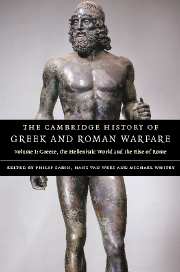Book contents
- Frontmatter
- Introduction: The Historiography of Ancient Warfare
- 1 The modern historiography of ancient warfare
- 2 Warfare in ancient literature: the paradox of war
- 3 Reconstructing ancient warfare
- Part I Archaic and Classical Greece
- Part II The Hellenistic World and the Roman Republic
- Chronological Table
- Glossary
- List of Ancient Authors
- Bibliography
- Index of ancient passages cited
- General index
- Map 1 The western Mediterranean
- Map 3 The Near East
- References
3 - Reconstructing ancient warfare
from Introduction: The Historiography of Ancient Warfare
Published online by Cambridge University Press: 28 March 2008
- Frontmatter
- Introduction: The Historiography of Ancient Warfare
- 1 The modern historiography of ancient warfare
- 2 Warfare in ancient literature: the paradox of war
- 3 Reconstructing ancient warfare
- Part I Archaic and Classical Greece
- Part II The Hellenistic World and the Roman Republic
- Chronological Table
- Glossary
- List of Ancient Authors
- Bibliography
- Index of ancient passages cited
- General index
- Map 1 The western Mediterranean
- Map 3 The Near East
- References
Summary
Reconstruction of ancient warfare can be pursued in a variety of ways. There is a long tradition of close attention to particular engagements: the battle narratives of Herodotus or Caesar appear to permit analysis of what happened and why in particular engagements. This focus, once much more academically prevalent than now, has by no means lost its popular appeal, thanks in part to the historical appetite of competing television companies. Individual battles are also considered within the context of the campaign or war to which they belong, since the strategy and tactics of a successful general, an Alexander, Hannibal or Caesar, might suggest lessons to contemporary commanders. The military activities of the ancient world generated material evidence in the form of walls and specialist buildings as well as equipment. This evidence does not often contribute crucially to ‘battles and commanders’ studies, but rather invites questions about purpose and operation at both the detailed level of the particular item and the larger scale of strategic conception, structural organization or diplomatic framework. Military activities were also depicted in a variety of artistic media, from the grand monuments of public propaganda through the scenes on particular painted vases to graffiti, all of which require sensitive interpretation. There is an enduring interest in ‘what it was like for them’, which embraces physical aspects of wielding an ancient weapon or sitting on a rower’s bench, the personal experience of battle, and psychological questions of the place of warfare in the mental framework of the population.
Keywords
- Type
- Chapter
- Information
- The Cambridge History of Greek and Roman Warfare , pp. 54 - 82Publisher: Cambridge University PressPrint publication year: 2007
References
- 5
- Cited by

